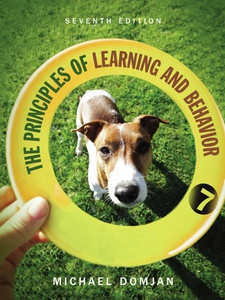
The Principles of Learning and Behavior 7th Edition by Michael Domjan, Marilyn Pooler, Carol Tamparo, Barbara Dahl
Edition 7ISBN: 978-1305142671
The Principles of Learning and Behavior 7th Edition by Michael Domjan, Marilyn Pooler, Carol Tamparo, Barbara Dahl
Edition 7ISBN: 978-1305142671 Exercise 2
Describe Descartes's conception of the reflex and how the concept of the reflex has changed since his time.
Explanation
The historical studies of the mind and reflexes have preceded the modern studies of learning behavior. Descartes changed the view that conscious intent and free will were the only factors that formed human behavior; he noticed that some behaviors in humans were automatic and therefore behavior was dual.
Descartes called the automatic part of the behavior "reflexive" and believed we were born with all our specific reflexive behaviors. Descartes believed that reflexes were produced by a single set of nerves, and this behavior was alternate to conscious behavior only in humans. Descartes believed that sense organs sent messages to the brain and that the same nerves that transmitted these messages also transmitted messages from muscles. He believed that nerves were tubular conduits for transmission of gases from the pineal gland in the brain, which stimulated the muscles by changing their volume (swelling them.)
As a result of early beliefs of reflexology, modern studies have disproved all of Descartes ideas. Instead of a single nerve to the pineal gland, we now know that separate nerves transmit information to different systems within the brain. We know that nerves are not hollow tubes but rather bundles of fibers that send and receive electric and chemical signals. We know that the pineal gland does not release a gaseous "spirit" and that other substances other than secretions of the pineal can stimulate muscles, and that muscles themselves do not change volume when stimulated. We have also learned that reflexive behavior is not always simple, and at times complex and independent of the stimulus; reflexive behavior can be influenced by conscious behavior. We also now know that reflexive behavior can be learned after birth through the power of associations, and today much of the neural mechanisms of learning are based on associative analysis (though some scientists do not support association as a component of their behavior analysis results.
Descartes called the automatic part of the behavior "reflexive" and believed we were born with all our specific reflexive behaviors. Descartes believed that reflexes were produced by a single set of nerves, and this behavior was alternate to conscious behavior only in humans. Descartes believed that sense organs sent messages to the brain and that the same nerves that transmitted these messages also transmitted messages from muscles. He believed that nerves were tubular conduits for transmission of gases from the pineal gland in the brain, which stimulated the muscles by changing their volume (swelling them.)
As a result of early beliefs of reflexology, modern studies have disproved all of Descartes ideas. Instead of a single nerve to the pineal gland, we now know that separate nerves transmit information to different systems within the brain. We know that nerves are not hollow tubes but rather bundles of fibers that send and receive electric and chemical signals. We know that the pineal gland does not release a gaseous "spirit" and that other substances other than secretions of the pineal can stimulate muscles, and that muscles themselves do not change volume when stimulated. We have also learned that reflexive behavior is not always simple, and at times complex and independent of the stimulus; reflexive behavior can be influenced by conscious behavior. We also now know that reflexive behavior can be learned after birth through the power of associations, and today much of the neural mechanisms of learning are based on associative analysis (though some scientists do not support association as a component of their behavior analysis results.
The Principles of Learning and Behavior 7th Edition by Michael Domjan, Marilyn Pooler, Carol Tamparo, Barbara Dahl
Why don’t you like this exercise?
Other Minimum 8 character and maximum 255 character
Character 255


